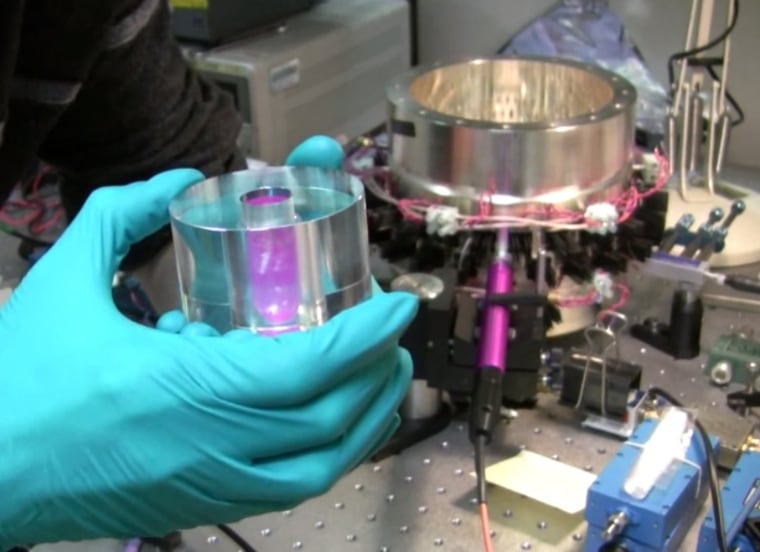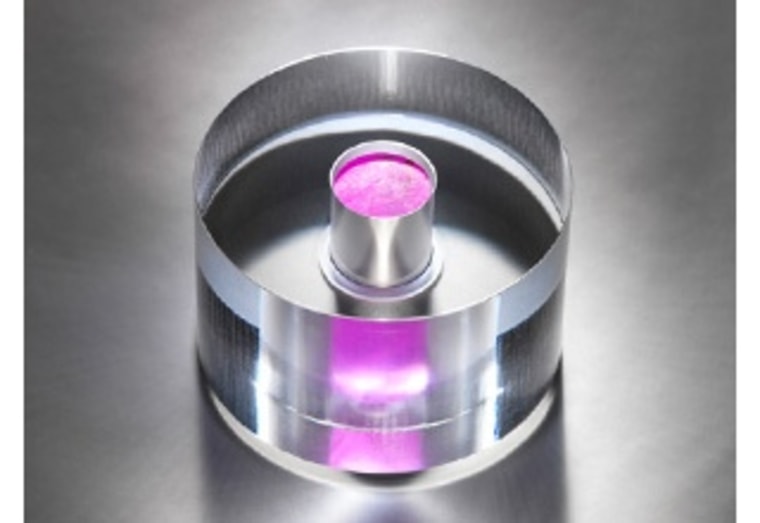
Masers, which are to microwave radiation what lasers are to light, have been more or less ignored for many years, but an almost accidental discovery by a British physicist has brought the maser back into the limelight; Mark Oxborrow's new model is 100 million times more powerful than any created before.
The term MASER is actually an acronym, like LASER: Microwave Amplification by Stimulated Emission of Radiation (for laser, substitute "light" for "microwave"). Time, familiarity, and ease of pronunciation have made both into ordinary words, though in research documents they are both occasionally kept capitalized. Masers actually came first, but certain limitations prevented widespread use.
Unlike lasers, masers only operated at near-absolute-zero temperatures, and even then only in powerful magnetic fields. So it's not surprising that lasers, later to come but far simpler to operate, became the widely used technology we know today.
Oxborrow, a British researcher on a shoestring budget, has just turned all things maser upside-down with a device that not only works at room temperature and without a magnetic field, but creates a microwave beam that is far, far more powerful than even its creators expected.

The secret, as it turned out, lay in a paper published in 2002 by Japanese chemists Takeda, Takegoshi and Terao. They suggested a whole new type of crystal; masers traditionally used ruby, but they theorized that something called p-terphenyl, doped with pentacene, would also work.
The pentacene technique went untried until Oxborrow, a physicist at the UK's National Physical Laboratory, decided to put together a test rig out of essentially spare parts. He bought a medical laser on eBay, borrowed some pentacene from his friends Jonathan Breeze and Neil Alford at Imperial College London, and baked up a crystal.
But even after constructing this jury-rigged device, Oxborrow was hesitant. He told Nature:
When you're designing experiments and you're very nervous about the outcome, sometimes one is almost too scared to try it. And for about 3 days before, I could have done it, but I didn't have the nerve to switch on that button to get to the moment of truth.
Instead what occurred was one of those seemingly trivial events that seems destined for scientific lore, like Newton's apple or Pythagoras' "Eureka!" moment: Oxborrow had gotten into an argument with Mrs. Oxborrow one night and, hoping to cool down, he went to the lab in a rotten and impetuous mood and hit the button.
And in true "Eureka" fashion, the results were immediate and mind-boggling: the device emitted a signal around 100 million times stronger than any maser had ever produced. Oxborrow reports that he swore a lot and talked to himself for a bit. The implications are quite serious: once refined and more carefully controlled (the experiment singed the crystal), this type of maser could be used in many fields as what is called a low-noise amplifier, especially for radio waves.
Here's Oxborrow himself showing off the solid-state maser device:
Radar, mobile phones, medical scanners — all these things could benefit from powerful and precise amplification — though it will be some time before the technology is stable enough to use. At the moment, it can only be used in a pulsed form, unlike the steady beam of a laser. But Oxborrow and the lab are hard at work changing this, and also think that they can multiply the power even further with a few modifications.
We won't be using handheld masers to cook our food any time soon, but this discovery does in fact fundamentally change a whole branch of emanation science. To produce and amplify beams of radiation far outside the range of visible light could be extremely transformative. Those who worked on the laser in the 1950s would be astonished at the multi-watt handheld lasers available today, as well as the varied uses to which we've put their once-academic amplified light systems. In a few years, we may be saying the same about maser-based devices.
Oxborrow's paper, Room-temperature solid-state maser, was published this week in the journal Nature.
Devin Coldewey is a contributing writer for NBC News Digital. His personal website is coldewey.cc.